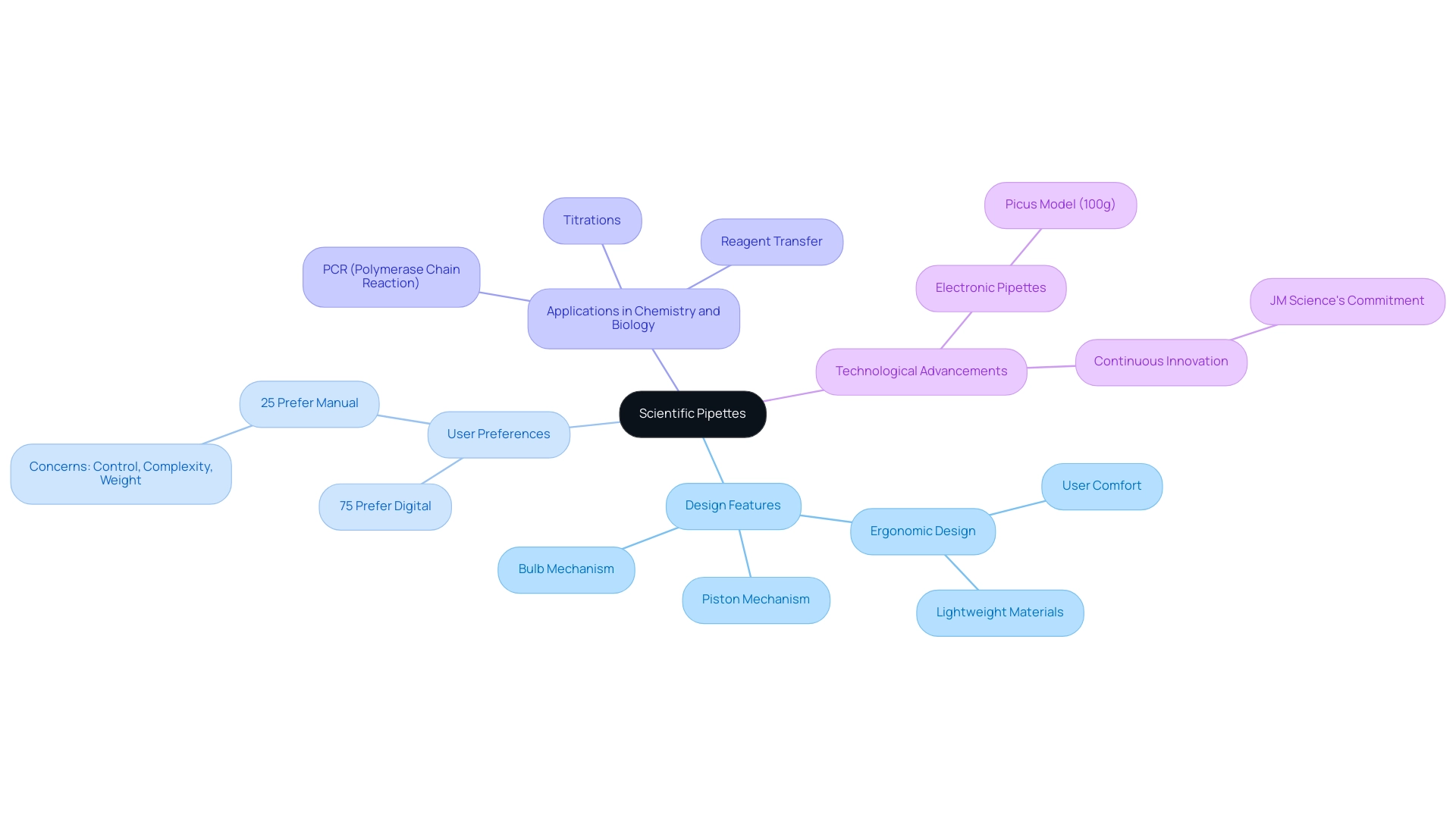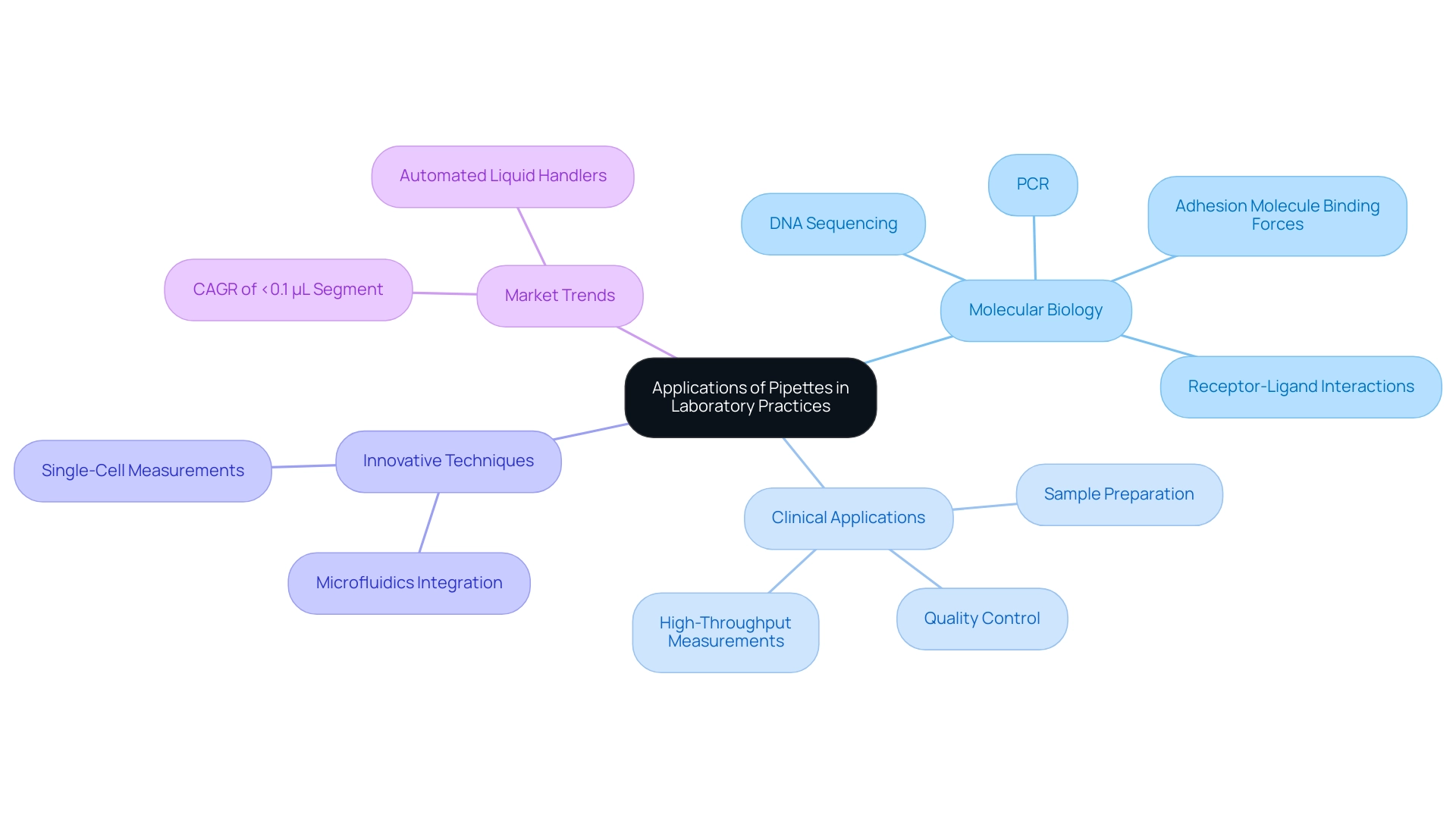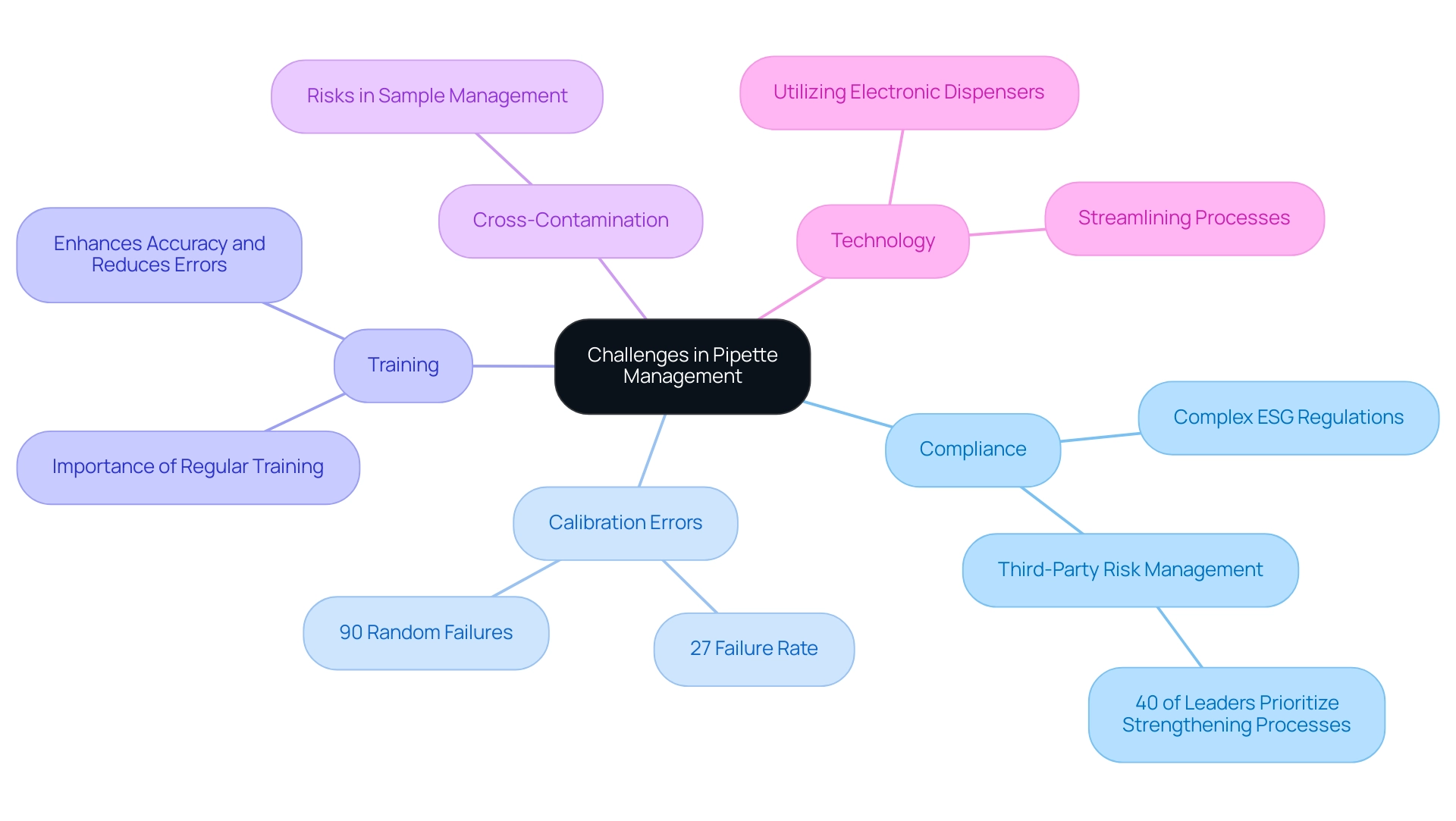Overview
Scientific pipettes are indispensable tools in laboratory settings, crucial for the precise transfer of measured fluid volumes. These instruments are primarily categorized into manual and electronic types, each tailored to fulfill specific functions in research environments. Understanding their significance is essential, as they play a vital role in applications across chemistry and biology.
Recent advancements in pipette technology have significantly improved accuracy and ergonomics, making them more user-friendly and efficient. This evolution not only enhances experimental outcomes but also underscores the necessity of selecting the right pipette for specific tasks. Proper maintenance is equally important, ensuring longevity and reliability in results.
In conclusion, the importance of high-quality scientific instruments like pipettes cannot be overstated. By investing in the right tools and adhering to best practices in maintenance and selection, researchers can elevate their work and achieve more reliable results in their experiments.
Introduction
In the intricate world of laboratory research, precision in liquid handling is paramount; pipettes are at the forefront of this essential task. These indispensable instruments empower scientists to measure and transfer minute volumes of liquids with unparalleled accuracy, playing a crucial role in everything from basic experiments to complex analyses.
As laboratories increasingly embrace technological advancements, a notable shift towards electronic pipettes is transforming traditional practices, enhancing both efficiency and user comfort.
This article explores the various types of pipettes, their applications across scientific disciplines, and the innovations shaping the future of liquid handling. It serves as a comprehensive guide for laboratory professionals seeking to optimize their pipetting techniques.
Defining Scientific Pipettes: An Overview
A dropper, frequently referred to as , is an indispensable laboratory tool widely utilized in chemistry and biology for the precise transfer of measured fluid volumes. This essential instrument facilitates accurate fluid handling, empowering scientists to measure and dispense small quantities of substances, typically ranging from microliters to milliliters. The design of a liquid transfer device typically features a slender tube equipped with either a bulb or a piston mechanism, generating suction to draw liquid into the tube.
The scientific pipette plays a critical role across diverse research environments, from preparing solutions to executing complex experiments. Its significance in scientific settings cannot be overstated. The reliance on a scientific pipette is vital for ensuring accuracy and reproducibility in experimental outcomes. Recent statistics reveal that an impressive 75% of laboratory professionals prefer digital dispensers over manual ones, primarily due to enhanced control and reduced physical strain (Technology Networks).
This shift towards digital options is further supported by insights from industry specialists, who note that only 25% of non-users express a preference for manual devices, often citing concerns regarding control, complexity, and weight.
The practical applications of tools like the scientific pipette are evident in both chemistry and biology. For example, in a chemistry lab, dropper tools are routinely employed to prepare standard solutions for titrations, ensuring precise concentrations that are critical for accurate results. In biological research, the scientific pipette is essential for transferring reagents and samples, playing a pivotal role in experiments such as PCR (Polymerase Chain Reaction), where minute volumes must be handled with utmost precision.
Recent advancements in this technology, particularly in 2025, have introduced ergonomic designs and lightweight materials, exemplified by the electronic Picus model, which weighs only 100 grams, making it the lightest electronic device of its kind available. These innovations not only enhance user comfort but also improve accuracy and efficiency in clinical practices. JM Science's commitment to providing such groundbreaking solutions underscores its role in advancing scientific technology.
Case studies further illustrate the importance of liquid handling devices in scientific environments. For instance, research conducted in a pharmaceutical laboratory demonstrated that the use of high-quality electronic devices significantly reduced variability in fluid handling, resulting in more reliable experimental outcomes. This aligns with JM Science's dedication to quality and customer support, as the company consistently updates its product offerings to meet the evolving needs of the scientific community.
In summary, a scientific pipette is essential for experimental applications, ensuring precision in liquid handling and contributing to the overall success of scientific research. Its continuous evolution reflects ongoing advancements in research technology, underscoring its critical role in modern scientific practices involving scientific pipettes.

Types of Scientific Pipettes: Manual vs. Electronic
Scientific pipettes are indispensable instruments in research environments, classified into two primary categories: manual and electronic. Manual devices, including micropipettes and serological types, require direct user handling, offering a tactile experience that many technicians appreciate. These devices are generally more cost-effective and simpler to maintain, establishing their presence as a staple in various testing environments.
Conversely, electronic dispensers come equipped with advanced features that significantly enhance their functionality. They enable programmable settings, improving precision while alleviating user fatigue during repetitive tasks. For instance, digital liquid handlers can fill an entire multi-well plate in under 30 seconds, making them especially beneficial in high-throughput laboratories.
A recent survey revealed that 77% of users of digital dispensers valued the simplification of workflows, with features such as multi-dispensing and automated mixing being particularly advantageous. Additionally, ergonomic benefits were noted, with 19% of participants indicating a reduced risk of upper limb injuries when using digital dispensing devices, underscoring their impact on user experience and productivity.
The choice between manual and digital instruments often hinges on specific research requirements and financial considerations. While many laboratory specialists remain loyal to manual tools due to familiarity and cost constraints, those working in environments with complex workflows may find that transitioning to digital alternatives enhances both productivity and precision. Expert insights suggest that the adoption of electronic dispensing devices is on the rise, particularly in settings focused on high-throughput tasks, where efficiency is paramount.
As Maiju Palokangas, a Product Manager in the Life Science Field, emphasizes, "Understanding and utilizing adequate products will make work in the lab easier, faster, and more reliable."
Understanding the distinctions among these types of instruments is crucial for selecting the appropriate tool for specific experimental applications. As research facilities continue to evolve, the integration of scientific pipettes is likely to increase, driven by the growing demand for precision and efficiency in scientific inquiry.
Applications of Pipettes in Laboratory Practices
A scientific pipette is integral to a wide range of experimental applications, encompassing solution preparation, dilutions, and assays. In the field of molecular biology, these pipettes are essential for critical processes such as PCR (Polymerase Chain Reaction) and DNA sequencing, where precision in liquid handling is vital. The accuracy provided by a scientific pipette is not merely a convenience; it is crucial for achieving reliable results in experiments that can lead to significant scientific breakthroughs.
In clinical environments, liquid dispensers are employed for sample preparation, where precise volume measurement is imperative for accurate test outcomes. Recent statistics indicate that a substantial number of facilities rely on droppers for clinical analysis, underscoring their importance in ensuring quality control and consistency in testing methodologies. Notably, it is estimated that the <0.1 µL segment will experience a CAGR of 4.6% from 2021 to 2026, reflecting the growing relevance of liquid handling devices in the market.
Innovative applications of micropipette aspiration have emerged, including the measurement of receptor-ligand interactions and the quantification of adhesion molecule binding forces. These advancements are paving the way for a deeper understanding in areas such as mechanobiology, where mechanical information acts as a label-free biomarker, potentially transforming clinical diagnostics. As highlighted by Allen P Liu from the University of Michigan, "Given the growing interest of mechanobiology and the use of mechanical information as a label-free biomarker, such development will likely find applications in clinical diagnostics and medicine."
A significant case study illustrates the integration of microfluidics with , resulting in devices capable of high-throughput single-cell measurements. This innovation not only streamlines data collection but also enhances the analysis of cellular behaviors, which is crucial for both research and clinical applications.
Expert opinions emphasize the vital role of the scientific pipette as a liquid handling device in clinical laboratories. Researchers note that the precision and reliability of techniques utilizing a scientific pipette directly influence the quality of diagnostic results. Furthermore, ongoing discussions in the scientific community, including the article series 'Minimizing Delivery Risk,' address the challenges posed by handheld dispensers, indicating a growing interest in automated fluid handling solutions to mitigate errors.
As the domains of molecular biology and clinical diagnostics continue to evolve, the significance of these tools remains unwavering, with ongoing advancements ensuring they meet the rigorous demands of contemporary scientific inquiry.

Choosing the Right Pipette and Tips for Your Needs
Selecting the appropriate instrument for laboratory applications, such as a scientific pipette, necessitates a thorough evaluation of several critical factors, including:
- The type of substance being handled
- The specific experimental application
For instance, a scientific pipette is engineered for precise measurements within the range of 1 µL to 1000 µL, making it particularly suitable for tasks demanding high accuracy with small volumes. Conversely, serological transfer devices cater to larger volumes, typically employed in cell culture and other scenarios where substantial fluid transfers are essential.
Equally significant is the selection of tips, which must be compatible with the chosen device and suitable for the liquid's viscosity and surface tension. Utilizing the correct tips not only enhances accuracy but also markedly diminishes the risk of contamination and errors in experimental outcomes. A recent case study titled 'Best Practices for Pipetting' underscored that employing a scientific pipette within its optimal volume range can lead to enhanced accuracy and precision.
This guidance encourages technicians to meticulously consider their target volume, ensuring they select a tool that aligns with their specific requirements. It is vital to recognize that pipetting errors frequently stem from not choosing the appropriate scientific pipette for the specific liquid handling application, highlighting the necessity of thoughtful selection.
Moreover, statistics indicate that improper selection of instruments is a common source of errors in research environments. For example, the Move It multi-channel device from Eppendorf can conserve up to 50% of valuable time during vessel format changes, illustrating how the correct tools can boost efficiency in the laboratory. Expert recommendations from laboratory technicians consistently emphasize ergonomic design and comfort as pivotal factors when choosing these instruments.
As Tamlyn Oliver, Content Development Lead at Biocompare, observes, "Ergonomic" and "comfortable" are among the primary features cited by product reviewers to describe their preferred tools, emphasizing user preferences that can significantly influence accuracy during repetitive tasks.
In 2025, it is imperative to remain informed about the latest guidelines for selecting pipettes based on volume range and application. JM Science continually updates its product offerings to align with the most recent pipetting technologies and practices, reinforcing its commitment to addressing the needs of research facilities. By prioritizing these considerations, research facilities can optimize their utilization of the scientific pipette, resulting in more reliable and reproducible outcomes in their scientific endeavors.
Maintaining Your Pipettes: Best Practices for Longevity
Proper upkeep of scientific pipettes is essential for ensuring their precision and durability, as these instruments are vital to research operations. Statistics indicate that some dispensing tools exhibit a higher failure rate than most other scientific equipment, underscoring the urgent need for meticulous maintenance. Best practices for maintaining scientific pipettes include:
- Regular calibration
- Thorough cleaning
- Appropriate storage
Calibration of scientific pipettes should ideally occur at least once a year; however, more frequent checks may be necessary depending on usage and regulatory guidelines. This proactive approach not only ensures that the pipette dispenses the correct volume but also enhances overall efficiency in the workspace by minimizing waste and preventing costly errors associated with incorrect fluid transfers.
Cleaning involves wiping the exterior of the pipette with a suitable disinfectant and ensuring that internal components are free from contamination, which can significantly impact performance. Furthermore, pipettes and other tools should be stored upright to prevent damage to the tips and internal mechanisms, thereby extending their lifespan.
Case studies, such as ',' demonstrate that facilities implementing consistent quality control measures for scientific pipettes—including establishing an appropriate calibration frequency based on the mean time between failures (MTBF) and desired reliability levels—have markedly improved their accuracy and reliability in liquid handling. Expert opinions highlight that regular calibration is not merely a regulatory requirement but a best practice leading to substantial cost efficiencies in operational procedures. As noted by Pipette.com, "Quaker asset management software provides you with excellent data management that makes calibrating with us all the more simple and convenient."
By adhering to these maintenance practices, laboratories can uphold high standards of accuracy and reliability in their scientific pipette usage, ultimately contributing to the integrity of their scientific results.

Challenges in Pipette Management: Compliance and Efficiency
Laboratory managers face significant challenges in managing liquid transfer instruments, particularly scientific pipettes, while ensuring compliance with regulatory standards and optimizing efficiency in liquid handling processes. A pressing issue is improper calibration, which can lead to inaccurate results and compromise research integrity. A study indicates that approximately 27% of monitored instruments failed during a six-month period, with 90% of these failures being random and unpredictable. This highlights the critical need for research facilities to anticipate potential failures and implement preventive measures.
Moreover, cross-contamination between samples poses a substantial risk, complicating the management of scientific pipettes. To address these challenges, it is essential for research facilities to invest in regular training for staff on the proper use of scientific pipettes. Data suggests that effective training significantly enhances accuracy and reduces errors, ultimately leading to improved results. As G. Rodrigues, PhD, PFQ, remarks, "The Mount Washington data highlight the significance of routinely checking measuring devices in the setting where they are utilized."
In addition to training, establishing a routine for the calibration and maintenance of scientific pipettes is vital. Utilizing electronic dispensers can streamline processes and reduce human error, thereby enhancing productivity in the lab. Expert insights indicate that incorporating technology into liquid handling management not only improves compliance but also fosters a culture of precision within the workspace.
As compliance challenges associated with liquid handling continue to rise, with 40% of legal and compliance leaders emphasizing the enhancement of third-party risk management procedures and technology, it is essential for managers to stay updated on regulatory standards. Furthermore, with 67% of global executives finding ESG regulation too complex, understanding these intricacies is crucial for effective compliance. By addressing these challenges directly and implementing best practices, facilities can significantly enhance and ensure the reliability of their results.

Innovations in Pipette Technology: The Future of Liquid Handling
The future of liquid handling technology is exceptionally promising, particularly with advancements in the scientific pipette that enhance accuracy, efficiency, and user experience. Intelligent liquid handling devices, including the scientific pipette, are now equipped with advanced sensors for real-time volume assessment and automated calibration, making them increasingly prevalent in research facilities. Not only does the scientific pipette simplify workflows, but it also significantly reduces human error, ensuring more reliable experimental results.
Recent progress in materials and ergonomic designs has led to the development of lighter, more comfortable tools, which help mitigate the risk of repetitive strain injuries among research staff. This focus on user comfort is crucial, as it directly impacts productivity and the overall well-being of researchers.
As workspaces evolve to meet new challenges and demands, these innovations are set to revolutionize fluid handling processes. For instance, the Asia Pacific market for liquid handling devices is projected to experience the highest growth rate, driven by increasing research activities and substantial investments in biotechnology infrastructure. This trend underscores the growing reliance on , such as the scientific pipette, in modern scientific research.
Moreover, case studies reveal that research facilities utilizing scientific pipettes are achieving enhanced precision and productivity in their operations. Notably, the report on highlights unique market dynamics across various regions, providing stakeholders with valuable insights for strategic decision-making. Additionally, Eppendorf's expansion of manufacturing capabilities in April 2022 signifies robust industry growth and innovation in liquid handling technology.
Furthermore, Trishita Deb noted that in 2023, RADWAG Balances and Scales unveiled the AP-12.1.5Y, the first automatic device specifically designed for calibrating single- and multi-channel micro dispensers with precision, adhering to ISO 8655 requirements. These advancements not only elevate the quality of research but also contribute to the broader objective of advancing scientific knowledge and healthcare outcomes. As we approach 2025, the integration of scientific pipettes and automated systems is poised to shape the future landscape of laboratory equipment, making it imperative for stakeholders to remain informed about these developments.
By consistently updating product offerings and fostering strong relationships with manufacturers, companies like JM Science are strategically positioned to meet the evolving needs of the scientific community.
Conclusion
Pipettes are indispensable tools that underpin the success of laboratory research, ensuring precision in liquid handling across various scientific disciplines. This article has examined the different types of pipettes—manual and electronic—highlighting their unique advantages and applications. The notable shift towards electronic pipettes is significant, as they offer enhanced efficiency, programmability, and reduced physical strain, making them increasingly preferred by laboratory professionals.
Moreover, the article explored the critical applications of pipettes in molecular biology and clinical laboratories, where accuracy can profoundly impact research outcomes and diagnostic results. As innovations in pipette technology continue to emerge, such as smart pipettes with real-time measurement capabilities, laboratories can anticipate improved workflows and reduced human error.
Choosing the right pipette and ensuring proper maintenance are essential for achieving reliable results. By adhering to best practices in pipette management, including regular calibration and staff training, laboratories can enhance their operational efficiency and compliance with regulatory standards.
As the field of liquid handling evolves, staying informed about advancements in pipette technology will be crucial for laboratory professionals. The ongoing integration of ergonomic designs and smart features promises to revolutionize laboratory practices, ultimately contributing to the advancement of scientific research and healthcare outcomes. Embracing these innovations will not only enhance productivity but also uphold the integrity of scientific inquiry, ensuring that pipettes remain indispensable in the quest for knowledge.




